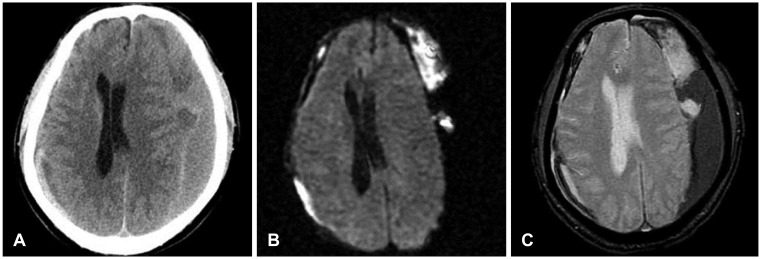Korean J Neurotrauma.
2017 Oct;13(2):149-152. 10.13004/kjnt.2017.13.2.149.
Postoperative Subarachnoid Hemorrhage and Multipunctate Intracerebral Hemorrhages Following Evacuation of Bilateral Chronic Subdural Hematomas
- Affiliations
-
- 1Department of Neurosurgery, Dongguk University Gyeongju Hospital, Dongguk University College of Medicine, Gyeongju, Korea. ktokhou@gmail.com
- KMID: 2394551
- DOI: http://doi.org/10.13004/kjnt.2017.13.2.149
Abstract
- Chronic subdural hematoma (CSDH) can be easily treated by burr hole surgery. However, several complications including intracerebral hemorrhage (ICH), subarachnoid hemorrhage (SAH), and acute subdural hematoma are rare after evacuation of a CSDH. A 77-year-old man was admitted with right hemiparesis and dysarthria. A brain computed tomography (CT) scan revealed a bilateral CSDH with midline shifting toward the right side. The patient got the burr hole trephination with the catheters insertion in the both sides of parietal area under the local anesthesia. After burr hole surgery immediately, he developed left side weakness and decreased level of consciousness. Repeat CT scans detected a diffuse SAH and multiple small ICHs. He was treated conservatively and fully recovered at discharge after 1 month. To avoid these complications, slow and gradual drainage of the CSDH is needed. The authors report a rare case of SAH and multipunctate ICHs in both cerebral hemispheres after evacuation of a bilateral CSDH.
MeSH Terms
Figure
Cited by 1 articles
-
Spontaneous Intracranial and Spinal Subdural Hematoma: A Case Report
Dae Gyun Kim, Yong Su Cho, Hui Sun Wang, Seok Won Kim
Korean J Neurotrauma. 2019;15(2):182-186. doi: 10.13004/kjnt.2019.15.e20.
Reference
-
1. Adhiyaman V, Asghar M, Ganeshram KN, Bhowmick BK. Chronic subdural haematoma in the elderly. Postgrad Med J. 2002; 78:71–75. PMID: 11807186.2. Dinc C, Iplikcioglu AC, Bikmaz K, Navruz Y. Intracerebral haemorrhage occurring at remote site following evacuation of chronic subdural haematoma. Acta Neurochir (Wien). 2008; 150:497–499. PMID: 18305890.
Article3. Gelabert-González M, Iglesias-Pais M, García-Allut A, Martínez-Rumbo R. Chronic subdural haematoma: surgical treatment and outcome in 1000 cases. Clin Neurol Neurosurg. 2005; 107:223–229. PMID: 15823679.
Article4. Hubschmann OR. Twist drill craniostomy in the treatment of chronic and subacute subdural hematomas in severely ill and elderly patients. Neurosurgery. 1980; 6:233–236. PMID: 7383285.
Article5. Jang KM, Kwon JT, Hwang SN, Park YS, Nam TK. Comparison of the outcomes and recurrence with three surgical techniques for chronic subdural hematoma: Single, double burr hole, and double burr hole drainage with irrigation. Korean J Neurotrauma. 2015; 11:75–80. PMID: 27169069.
Article6. Kotwica Z, Brzeziński J. Chronic subdural haematoma treated by burr holes and closed system drainage: personal experience in 131 patients. Br J Neurosurg. 1991; 5:461–465. PMID: 1764227.
Article7. Mckissock W, Richardson A, Bloom WH. Subdural haematoma. A review of 389 cases. Lancet. 1960; 275:1365–1369.8. Miyazaki T, Matsumoto Y, Ohta F, Daisu M, Moritake K. A case of unknown origin subarachnoid hemorrhage immediately following drainage for chronic subdural hematoma. Kurume Med J. 2004; 51:163–167. PMID: 15373234.
Article9. Modesti LM, Hodge CJ, Barnwell ML. Intracerebral hematoma after evacuation of chronic extracerebral fluid collections. Neurosurgery. 1982; 10:689–693. PMID: 7110541.
Article10. Mori K, Maeda M.clinical characteristics, surgical outcome, complications, and recurrence rate. Neurol Med Chir (Tokyo). 2001; 41:371–381. PMID: 11561347.11. Muneza S, Rasoloherimampiononiaina MR, Nduwamariya MJ. Postoperative intracerebral and intraventricular hemorrhages following removal of a chronic subdural hematoma. J Clin Neurosci. 2009; 16:1346–1348. PMID: 19560929.
Article12. Ogasawara K, Koshu K, Yoshimoto T, Ogawa A. Transient hyperemia immediately after rapid decompression of chronic subdural hematoma. Neurosurgery. 1999; 45:484–488. PMID: 10493370.
Article13. Ogasawara K, Ogawa A, Okuguchi T, Kobayashi M, Suzuki M, Yoshimoto T. Postoperative hyperperfusion syndrome in elderly patients with chronic subdural hematoma. Surg Neurol. 2000; 54:155–159. PMID: 11077097.
Article14. Rusconi A, Sangiorgi S, Bifone L, Balbi S. Infrequent hemorrhagic complications following surgical drainage of chronic subdural hematomas. J Korean Neurosurg Soc. 2015; 57:379–385. PMID: 26113968.
Article
- Full Text Links
- Actions
-
Cited
- CITED
-
- Close
- Share
- Similar articles
-
- Spontaneous Spinal Subdural and Subarachnoid Hemorrhage with Concomitant Intracerebral Hemorrhage: A Case Report
- Inteacerebral and Brain Stem Hemorrhage Following Evacuation of Chronic Subdural Hematoma and Hygroma
- Infrequent Hemorrhagic Complications Following Surgical Drainage of Chronic Subdural Hematomas
- "Contralateral" Acute Subdural and Intracerebral Hemorrhage Occurring Simultaneously after Evacuation of Huge Chronic Subdural Hematoma
- Intracerebral Hemorrhage Following Evacuation of a Chronic Subdural Hematoma



